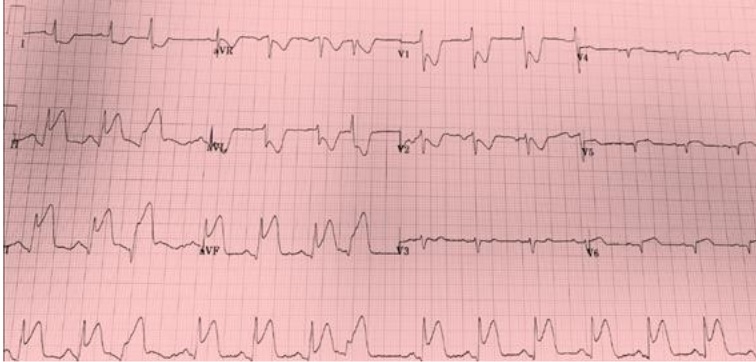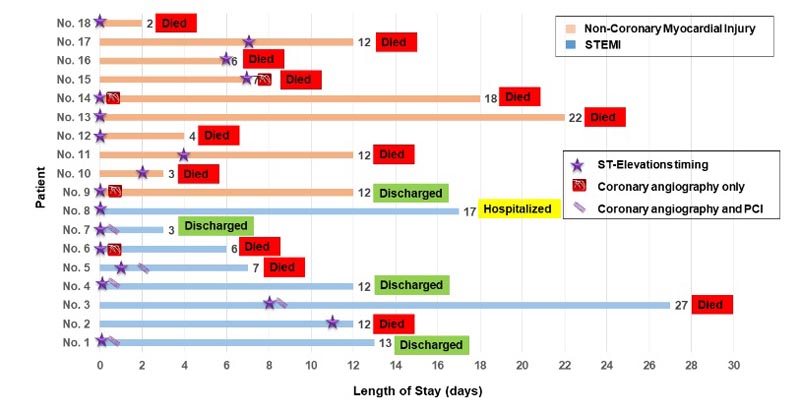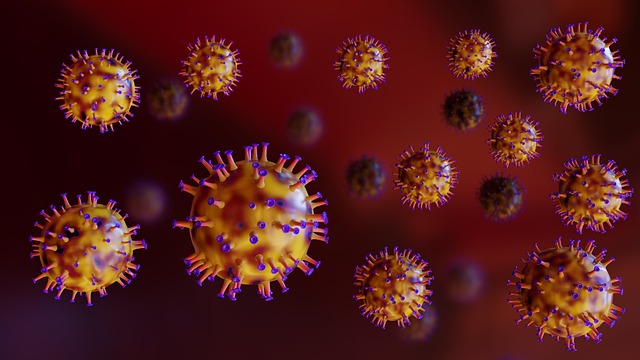Myocardial injury with ST segment elevation has been observed in patients with coronavirus disease 2019 (Covid-19). Here, we describe our experience in the initial month of the Covid-19 outbreak in New York City.
Patients with confirmed Covid-19 who had ST-segment elevation on electrocardiography were included in the study from six New York hospitals.
Covid-19 patients who had non-obstructive disease on coronary angiography or had normal wall motion on echocardiography in the absence of angiography were presumed to have non-coronary myocardial injury.
We identified 18 patients with Covid-19 who had ST segment elevation, indicating possible acute myocardial infarction.
 Example, ECG patient 4
Example, ECG patient 4
The median age of the patients was 63 years , 83% were men, and 33% had chest pain at the time of ST segment elevation.
A total of 10 patients (56%) had ST-segment elevation at presentation, and the other 8 patients developed ST-segment elevation during hospitalization (median, 6 days).
Of 14 patients (78%) with focal ST-segment elevation, 5 (36%) had a normal left ventricular ejection fraction , of whom 1 (20%) had a regional wall motion abnormality ; 8 patients (57%) had reduced left ventricular ejection fraction , of whom 5 (62%) had regional wall motion abnormalities . (One patient did not have an echocardiogram).
Of the 4 patients (22% of the general population) with diffuse ST-segment elevation, 3 (75%) had a normal left ventricular ejection fraction and normal wall motion; 1 patient had a left ventricular ejection fraction of 10% with global hypokinesia.
A total of 9 patients (50%) underwent coronary angiography ; 6 of these patients (67%) had obstructive disease and 5 (56%) underwent percutaneous coronary intervention (1 after administration of fibrinolytic agents).
The 8 patients (44%) who received a clinical diagnosis of myocardial infarction had higher mean troponin and d-dimer levels than the 10 patients (56%) with noncoronary myocardial injury.
A total of 13 patients (72%) died in the hospital (4 patients with myocardial infarction and 9 with non-coronary myocardial injury).
In this series of Covid-19 patients who had ST segment elevation, there was variability in presentation, a high prevalence of non-obstructive disease, and a poor prognosis.
Half of the patients underwent coronary angiography, of whom two-thirds had obstructive disease.
Of note, all 18 patients had elevated d-dimer levels . In contrast, in a previous study involving patients who presented with ST-segment elevation myocardial infarction, 64% had normal d-dimer levels.
Timing of ST segment elevation, length of stay, and outcome
 Note that coronary angiography with or without PCI at the time of ST elevations (except patient 5). Patient no. Patient #5 received thrombolytic therapy at the time of ST segment elevation and underwent PCI one day later.
Note that coronary angiography with or without PCI at the time of ST elevations (except patient 5). Patient no. Patient #5 received thrombolytic therapy at the time of ST segment elevation and underwent PCI one day later.
|
















